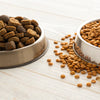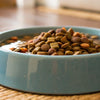What is Better: Wet or Dry Food for Dogs?
- Houndsy
Table of Contents
- Introduction
- The Basics of Dog Food: Wet vs. Dry
- Benefits of Wet Food
- Benefits of Dry Food
- Making the Right Choice for Your Dog
- Conclusion
Introduction
Did you know that over 60% of dog owners struggle with choosing the right food for their furry friends? As devoted pet parents, we often find ourselves standing in the pet food aisle, bombarded by a plethora of options—each promising to be the best for our beloved companions. The age-old debate of what is better: wet or dry food for dogs continues to baffle many of us.
Understanding the differences between wet and dry dog food is crucial for making informed decisions that impact our dogs' health, happiness, and overall well-being. In this blog post, we will explore the characteristics of both types of dog food, their benefits and drawbacks, and help you determine which option may be best for your dog. By the end, we hope you will feel confident in your choices and how they fit into your pet's daily feeding routine.
Join us as we delve deep into this canine culinary conundrum, and reflect on your own experiences feeding your dog. Do you notice preferences? Health changes? Let’s find out together!
The Basics of Dog Food: Wet vs. Dry
Understanding Dry Dog Food
Dry dog food, often referred to as kibble, typically contains around 10% moisture. Its primary ingredients generally include meat, grains, and various nutrients, processed into a shelf-stable form. Here’s a closer look at its composition:
- Processing: The ingredients are ground, mixed, and then cooked to create a dough-like consistency, which is extruded into various shapes and sizes of kibble. After cooking, the kibble is dried to remove excess moisture.
- Nutrient Density: Due to the low moisture content, dry dog food is more nutrient-dense than wet food. Owners tend to feed less volume of kibble compared to wet food to meet their dog’s nutritional needs.
- Variety: Kibble comes in numerous flavors, formulas, and textures, catering to different breeds, ages, and dietary requirements.
Understanding Wet Dog Food
Wet dog food, also known as canned food, contains about 75-85% moisture. Its composition generally includes meat, grains, and a gravy or broth that enhances flavor and aroma. Here’s what makes it unique:
- Processing: Wet food is made by grinding meat and other ingredients, then mixing them with water and additives before cooking and canning the mixture. This process preserves the food while retaining moisture.
- Palatability: The aroma and texture of wet food are often more enticing to dogs. This makes it a great choice for picky eaters or dogs recovering from illness.
- Hydration: The high moisture content can aid in hydration, especially for dogs who may not drink enough water daily.
Benefits of Wet Food
1. Higher Moisture Content
One of the standout features of wet food is its moisture content, which can benefit dogs in several ways:
- Hydration: Wet food can help prevent dehydration, particularly in dogs that don’t drink enough water. This is especially crucial for dogs with kidney issues or urinary tract concerns.
- Easier Swallowing: For older dogs or those with dental issues, wet food can be easier to chew and digest.
2. Palatability
Many dogs find wet food more appealing due to its rich aroma and taste. This can be especially beneficial when:
- Encouraging Appetite: If your dog is recovering from illness or is a fussy eater, the enhanced flavor of wet food may entice them to eat.
- Weight Management: The increased moisture can help dogs feel fuller without consuming excess calories, assisting in weight management.
3. Nutritional Benefits
Wet food can also provide some unique nutritional advantages:
- Higher Protein and Fat: Many wet foods contain higher levels of protein and fat compared to dry food, which can be beneficial for active or working dogs.
- Enhanced Nutrient Absorption: The moist environment can aid digestion and nutrient absorption, especially for dogs with sensitive stomachs.
Benefits of Dry Food
1. Dental Health
One of the significant advantages of dry food is its potential benefits for dental health:
- Chewing Action: The crunchiness of kibble encourages dogs to chew, which can help reduce plaque and tartar buildup, promoting healthier teeth and gums.
2. Convenience
Dry food offers a level of convenience that many pet parents appreciate:
- Storage and Shelf-Life: Kibble has a longer shelf life and is easier to store. It can be left out for longer periods without spoiling, making it an excellent choice for grazing dogs.
- Portion Control: Measuring dry food is straightforward, allowing for precise portion control, which is essential for maintaining a healthy weight.
3. Cost-Effectiveness
Dry food is often more economical:
- Lower Cost: Generally, dry dog food is less expensive than wet food, making it a more budget-friendly option for many families.
- Longer Lasting: A single bag of kibble can last longer than multiple cans of wet food, reducing the frequency of purchases.
Making the Right Choice for Your Dog
1. Consider Your Dog's Needs
When deciding between wet and dry food, consider your dog's individual health, lifestyle, and preferences:
- Health Concerns: If your dog has specific health issues (like kidney disease), consult your veterinarian about the best food choice.
- Life Stage: Puppies, adults, and senior dogs have different nutritional needs that should guide your decision.
2. Mixing Wet and Dry Food
For some pet parents, a combination of both wet and dry food can offer the best of both worlds:
- Enhanced Flavor: Mixing wet food with kibble can make meals more appealing and palatable, particularly for picky eaters.
- Balanced Diet: This approach can provide the hydration benefits of wet food while maintaining the dental health advantages of dry food.
3. Consult Your Veterinarian
Ultimately, your veterinarian is the best resource for determining the right diet for your dog:
- Tailored Recommendations: They can offer guidance based on your dog's specific health needs, weight management goals, and food preferences.
Conclusion
The debate over what is better: wet or dry food for dogs doesn't have a one-size-fits-all answer. Both types of food have their unique benefits and drawbacks, and the best choice will depend on your dog's individual needs.
As a responsible pet parent, being informed about the options available is crucial to ensuring our dogs receive the nutrition they require. Whether you choose wet, dry, or a combination of both, remember to prioritize your dog’s health and happiness.
And speaking of enhancing your dog's daily feeding ritual, we invite you to explore the Houndsy Kibble Dispenser. Designed with both functionality and aesthetics in mind, our dispenser ensures perfect portion control, eliminates mess, and complements your home decor beautifully. Check it out here.
FAQ
What is the main difference between wet and dry dog food?
The primary difference lies in their moisture content—dry food typically contains about 10% moisture, while wet food has 75-85%. This affects their texture, taste, and overall nutritional profile.
Can I mix wet and dry dog food?
Yes! Many pet owners choose to mix both types of food to provide their dogs with a varied texture and taste while ensuring they receive adequate hydration and nutrition.
Is one type better for dogs with health issues?
It can depend on the condition. Wet food may be better for dogs with hydration issues or dental problems, while dry food can benefit dental health. Always consult your veterinarian for specific recommendations.
How do I know how much to feed my dog?
Refer to the feeding guidelines on the dog food packaging, and consult your veterinarian for tailored advice based on your dog's weight, age, and activity level.
What are some recommended brands for wet and dry food?
Popular and veterinary-recommended brands include Hill's Science Diet, Royal Canin, and Purina Pro Plan. However, always choose a food that meets your dog's specific health needs and dietary preferences.












